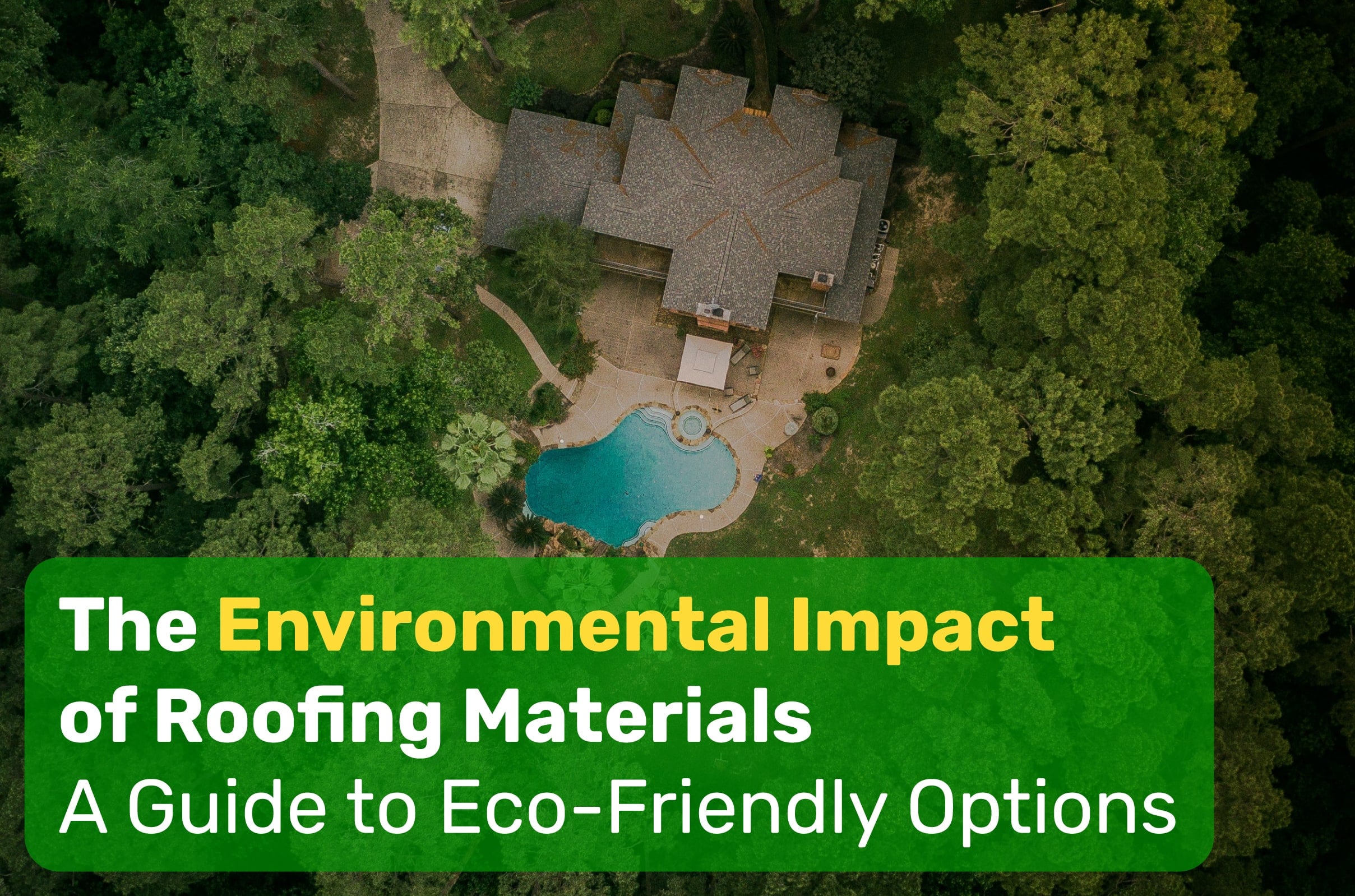Introduction:
Roofing materials are a critical component in determining a building’s overall environmental impact. The selection of roofing material affects the building’s energy efficiency, durability, recyclability, and waste generated during construction and demolition. The most commonly used roofing materials include asphalt shingles, metal, tile, and wood. However, the environmental impact of each material varies significantly. While asphalt shingles are affordable and easy to install, their short lifespan and non-recyclability lead to waste ending up in landfills. Metal roofing, on the other hand, is durable and sustainable, with a lifespan of up to 50 years, and 100% recyclable, reducing waste. Tile roofing is heavy and challenging to install, increasing installation costs and energy consumption, but is made from recyclable materials. Wood shingles are a natural and renewable resource but have a shorter lifespan and pose environmental concerns when sourced from deforested regions. One sustainable option is using wood from responsibly managed forests. Solar shingles are a newer roofing material that combines solar panel functionality with traditional roofing. The shingles generate clean energy and can save homeowners money on their energy bills. The environmental impact of roofing materials plays a vital role in creating eco-friendly buildings and reducing their carbon footprint. Therefore, builders, architects, and homeowners should carefully consider the environmental impact of different roofing materials when constructing or renovating buildings.
What is the environmental impact of roofing materials?
Roofing materials play a significant role in determining the overall environmental impact of a building. The type of roofing material used affects the energy efficiency of a building, as well as its durability, recyclability, and the amount of waste generated during construction and demolition.
The most common roofing materials used in construction are asphalt shingles, metal, tile, and wood. However, each of these materials has varying degrees of environmental impact.
Asphalt shingles are the most popular roofing material due to their affordability and easy installation. However, they have a short lifespan and are not recyclable, which means they end up in landfills. Moreover, the manufacturing process of asphalt shingles emits toxic chemicals into the air, contributing to air pollution.
Metal roofing is a more durable option, and its longevity makes it a sustainable choice. Additionally, it is recyclable and can be made from recycled materials, reducing waste. However, the production of metal roofing can contribute to air pollution and greenhouse gas emissions, and it may require additional insulation to maintain energy efficiency.
Tile roofing is made from clay, concrete, or slate, and has a longer lifespan than asphalt shingles. It is also recyclable and can be made from recycled materials. However, tile roofing is heavy and can be difficult to install, which requires more energy and may increase installation costs.
Wood shingles or shakes are a natural roofing material and can be sustainable if sourced from responsibly managed forests. However, they have a shorter lifespan and are more prone to damage from weather and pests. Additionally, the production of wood shingles contributes to deforestation, which has a significant impact on the environment.
Wood
Wood is a traditional roofing material that has been used for centuries. It is a natural and renewable resource that is widely available and easy to work with. However, the environmental impact of using wood for roofing depends on the source of the wood and how it is processed.
One of the main concerns with using wood for roofing is deforestation. When forests are cleared to harvest wood, it can have significant environmental impacts, including habitat destruction, loss of biodiversity, and increased greenhouse gas emissions. However, if the wood is sourced from sustainably managed forests, it can be a more environmentally friendly option.
Another factor to consider is the energy required to process and transport the wood. The manufacturing process for wood roofing involves cutting, drying, and shaping the wood, which requires energy. The transportation of the wood to the construction site also requires energy and can contribute to greenhouse gas emissions. However, using locally sourced wood can help reduce the environmental impact of transportation.
One of the benefits of using wood for roofing is that it is biodegradable and can be easily recycled or repurposed at the end of its useful life. This reduces the amount of waste that goes to landfills and can help reduce the environmental impact of roofing materials.
Metal Roofing
Metal roofing is a popular roofing option that has a relatively low environmental impact. This is because metal is a highly durable material that can last for up to 50 years or more. Additionally, metal roofing is 100% recyclable, which means that at the end of its life cycle, it can be reused to make other products.
When compared to other roofing materials like asphalt shingles, metal roofing is much more eco-friendly. Asphalt shingles are petroleum-based and have a relatively short lifespan, which means they end up in landfills at a high rate. Additionally, the production of asphalt shingles generates greenhouse gas emissions and other pollutants.
On the other hand, metal roofing is typically made from recycled materials, and the production process has a lower environmental impact than other roofing materials. This is because metal is lightweight, so it requires less energy to transport and install compared to heavier materials like concrete or clay tiles.
Metal roofing can also be coated with reflective finishes to reduce the amount of heat absorbed by the building. This can lead to lower energy consumption and costs by reducing the need for air conditioning. Additionally, metal roofs are resistant to fire, rot, and insects, which means that they require less maintenance and fewer resources to keep them in good condition.
One concern with metal roofing is that it can be noisy in rainy or hailstorm conditions. However, this can be mitigated by adding insulation or soundproofing materials during installation. Another potential downside is that metal roofs can be more expensive than other roofing options, but the long lifespan and durability can make it a cost-effective choice in the long run.
Solar Shingles
Solar shingles are a type of roofing material that combines the functionality of traditional
roofing with the added benefit of solar panels. Solar shingles are designed to look like traditional roofing shingles, but they generate electricity from the sun, making them an eco-friendly option for roofing.
Solar shingles are made from photovoltaic (PV) cells that are encased in a protective layer of glass and laminated to a durable substrate. They are designed to withstand various weather conditions, including rain, hail, and strong winds. The PV cells in solar shingles are capable of converting sunlight into electricity that can be used to power a home or building.
One of the significant advantages of solar shingles is that they are a clean source of energy. They do not produce harmful emissions that can contribute to air pollution or climate change. Additionally, solar shingles are an excellent option for those who live in areas with abundant sunlight.
Another advantage of solar shingles is that they can help homeowners save money on their energy bills. Solar shingles generate electricity that can be used to power a home, which means homeowners can reduce their reliance on grid power. This can lead to lower energy bills, as well as reduced dependence on fossil fuels.
Furthermore, solar shingles are a long-lasting and durable roofing option. They are designed to withstand various weather conditions and have a lifespan of around 25 years. Moreover, solar shingles require very little maintenance and can be installed without the need for special equipment or training.
Conclusion
In conclusion, the selection of roofing material can significantly impact a building’s environmental footprint, and builders, architects, and homeowners should carefully consider the environmental impact of different roofing materials when constructing or renovating buildings. The most commonly used roofing materials include asphalt shingles, metal, tile, wood, and solar shingles. While each material has unique benefits and drawbacks, metal roofing emerges as a more environmentally friendly option due to its durability, recyclability, and sustainable production process. In contrast, asphalt shingles have a short lifespan and are not recyclable, contributing to landfills and pollution. Tile roofing is made of recyclable materials but can be challenging to install, increasing installation costs and energy consumption. Wood shingles can be sustainable if sourced from responsibly managed forests but have a shorter lifespan and can contribute to deforestation.
Moreover, solar shingles have recently emerged as an environmentally friendly option that generates clean energy, reduces energy consumption, and can save homeowners money on their energy bills. However, the high initial cost of installation and the limited availability of skilled professionals may deter some homeowners from choosing solar shingles. Overall, the roofing material’s environmental impact is critical in creating eco-friendly buildings and reducing their carbon footprint. Therefore, informed decisions and careful consideration of the environmental impact of roofing materials should be a priority for everyone involved in the construction and renovation process.



